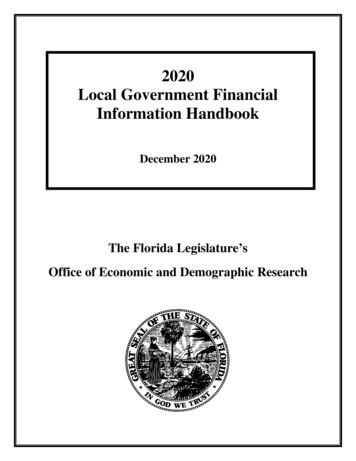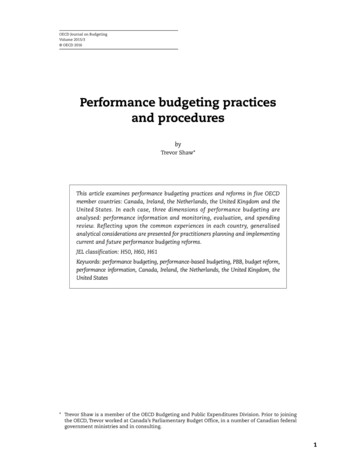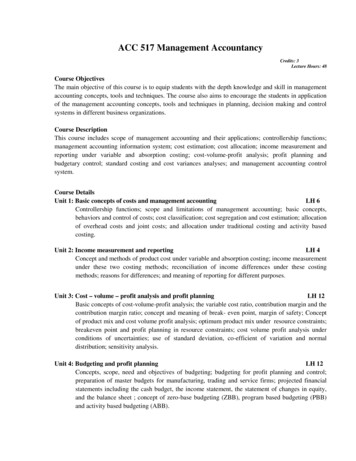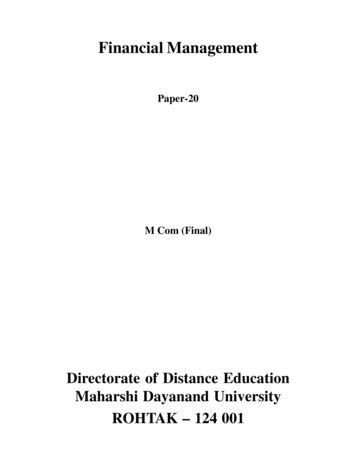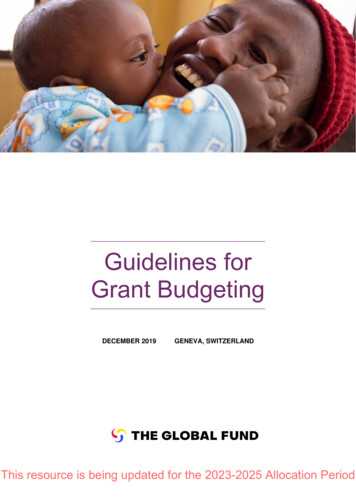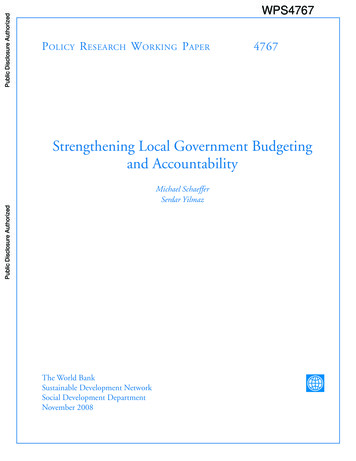
Transcription
Public Disclosure AuthorizedP olicy R esearch W orking P aperPublic Disclosure Authorized4767Strengthening Local Government Budgetingand AccountabilityMichael SchaefferSerdar YilmazPublic Disclosure AuthorizedPublic Disclosure AuthorizedWPS4767The World BankSustainable Development NetworkSocial Development DepartmentNovember 2008
Policy Research Working Paper 4767AbstractIn many developing and middle-income countries,decentralization reforms are promoting changes ingovernance structures that are reshaping the relationshipbetween local governments and citizens. The success ofthese decentralization reforms depends on the existenceof sound public financial systems both at the central andlocal levels. This paper focuses on the role of budgetingas a critical tool in reform efforts, highlighting problemsthat might impede successful local government budgetdevelopment and implementation. The attainmentof effective local government accountability andtransparency is not an end itself, but rather it representsthe means to support better decision-making on nationaland local budgeting. Community based schemes forenhancing local government accountability need tocombine legal, political, and administrative mechanismswith proactive community involvement. Of particularimportance are the legal and budgetary instruments thatrequire input from local community members on certainlocal government decisions and instruments that increaseaccessibility for the press or the general public at large toinformation on government activities.This paper—a product of the Social Development Department, Sustainable Development Network—is part of a largereffort in the department to study local governance systems and decentralization in the client countries. Policy ResearchWorking Papers are also posted on the Web at http://econ.worldbank.org. The author may be contacted at syilmaz@worldbank.org.The Policy Research Working Paper Series disseminates the findings of work in progress to encourage the exchange of ideas about developmentissues. An objective of the series is to get the findings out quickly, even if the presentations are less than fully polished. The papers carry thenames of the authors and should be cited accordingly. The findings, interpretations, and conclusions expressed in this paper are entirely thoseof the authors. They do not necessarily represent the views of the International Bank for Reconstruction and Development/World Bank andits affiliated organizations, or those of the Executive Directors of the World Bank or the governments they represent.Produced by the Research Support Team
Strengthening Local Government Budgeting andAccountabilityByMichael Schaeffer* and Serdar Yilmaz**The authors thank Richard Allen for helpful comments and suggestions. The findings, interpretations, andconclusions are entirely those of authors, and do not represent the views of the World Bank, its executivedirectors, or the countries they represent. Corresponding author: Serdar Yilmaz.* Senior Advisor (Consultant). MGSchaeffer1@gmail.com, phone 1-202-580-8511.** Social Development Department, World Bank, 1818 H Street, NW, Washington D.C. 20433;Syilmaz@worldbank.org; phone: 1-202-473-9350.1 Page
Table of Contents1 Introduction . 32 Theory and Evolution of Budgeting . 53 Connecting Budget with Policy Objectives. 73.1Line Item Budget Predominate Method of Local Government Budgeting. 83.2Program Budgeting at the Local Government Level . 94 Achieving Decentralized Accountability. 114.1Bottom-up Pressures: The Missing Link in Budgeting Reforms. 114.2Central and Local Government Reporting Relationship. 135 Demand Side Pressures for Downward Accountability . 145.1Local Government Must Show Leadership . 155.2Improving Local Public Sector Accountability . 155.3Consultation and Participation at the Local Level. 166 The Future of Budget Reform . 19References. 212 Page
Strengthening Local Government Budgeting andAccountability1IntroductionAcross many developing and middle-income countries, reforms are beingundertaken to improve governance by introducing new institutional and technical systemsintended to increase the transparency and accountability of governments. Most evidentare efforts to decentralize government functions to lower tiers of government. Throughthese reforms, governments are promoting changes to governance structures that arereshaping the relationship between local governments and citizens. However, the successof these reforms depends on the existence of sound public financial systems both at thecentral and local levels: weak or non-existent or absent public financial managementfunctions and institutions are likely to negate any advantages that might be inherent inbringing public services “closer” to people (Ahmad, Albino-War and Singh 2006). As aprimary financial management tool of governments, the annual budget is a logical placeto focus reform efforts. Budgets intersect with all aspects of governance reform includingfiscal policy, administrative reform, anticorruption efforts, social policy and servicedelivery.At the local level, local 1 government budgeting can be described as a series ofsteps that link policy (people’s preferences and needs) to financial planning (budget) toactual budget implementation (service delivery, operations). While efforts on localgovernment budgeting innovations in developing and middle-income countries arerelatively new, and few quantitative evaluations have emerged, anecdotal evidencesuggests that increased local community involvement in the budget process can lead toimprovements in budget efficiency, service delivery and investment in underserved areas.Local government budget innovations are designed to improve financialaccountability, which requires that municipal governments prudently manage theirfinances to ensure integrity in their financial and non-financial reporting, control,budgeting, and performance systems (Sahgal and Chakrapani 2000). Financialaccountability also necessitates reporting comprehensively on what local governmentshave achieved with their expenditures. Financial accountability of local governments isstrengthened by integrating approaches that marry supply-side public sectoraccountability (i.e. publicly available audit findings) with demand-side socialaccountability instruments (i.e. accessible local government financial information).1We use the terms subnational, local and municipal interchangeably throughout the text to refer to levels ofgovernment below the central government.3 Page
The supply side of accountability, which is also known as public accountability, 2is the hallmark of and a sine qua non for good governance (Bovens 2006). Supply sidemeasures to improve downward financial accountability include strong local capacity forbudgeting and public financial management; standards for control on intergovernmentaltransfer revenues (i.e., clean audit reports, submission of financial statements);publication of transfer figures; transparent local public audit systems—with publiclyavailable audit findings, clear rules for responsible local borrowing (including rulesregarding defaults), public access to borrowing information, and clearly defined rulesregarding hard budget constraints for local governments.Demand side accountability, also known as social accountability, refers to a broadrange of actions and mechanisms beyond voting that citizens can use to hold the state andproviders of public services accountable. Demand side measures for financialaccountability include publicly accessible local government financial information(including budgets, end-of-year financial statements and periodic implementationprogress reports during fiscal year); public involvement in budgetary process throughparticipatory budgeting practices; gender-sensitive planning, budgeting, and resourceallocation, reinforced by gender audits; independent budget analysis and participatorypublic expenditure tracking programs that monitor budget execution and leakage offunds.The focus of this paper is to outline the role of budgeting as a critical tool of localgovernment finance in developing and middle-income countries; highlighting problemsthat might impede successful local government budget development and implementation.The paper presents guidelines and suggestions for improvements to strengthen localbudgeting practices in developing countries. We assert that local governmentaccountability and transparency is not an end itself, but rather it represents the means tosupport better decision-making on national and local budgeting. We also provideevidence that community (demand-side) participation is necessary, but not a sufficientcondition, for enabling greater local government accountability. Community basedschemes for enhancing local government accountability generally need to combine legal,political, and administrative mechanisms with proactive community involvement. Ofparticular importance are the legal and budgetary instruments that require input fromlocal community members on certain local government decisions and instruments thatincrease accessibility for the press or the general public at large to information ongovernment activities.2Public accountability refers to the institutionalized practice of account giving—it focuses on public sectormanagers who spend public money, exercise public authority, and manage a corporate body under publiclaw. Public account giving provides political representatives and voters with the necessary inputs forjudging the fairness, effectiveness, and efficiency of their governance system (Manin, Przeworski, andStokes 1999). The formal doctrine of elected representatives’ responsibility rests upon the notion ofrepresentative democracy and parliamentary sovereignty. The elected representatives of people—parliament—bring the government—the executive—to account. Parliament enacts administrative laws toenforce accountability. On the other hand, poor governance and lack of public sector accountability mayresult from a number of factors including civil service incompetence, lack of efficient institutions, andpervasive corruption (Schaeffer 2005).4 Page
2Theory and Evolution of BudgetingIn social sciences a theory is a testable model of human interactions capable ofpredicting future occurrences or events of the same kind as well as capable of beingtested through experiment or otherwise verified through observation. Budgeting does nothave a theory in the classical sense of providing an orientation to the field, statingassumptions and pointing to some hypotheses about what causes what (Rubin 1997).According to Rubin, budget theory “is fragmented and incomplete [it] is in the processof being invented” (Rubin 1997: 185). In other words, the theory of effective budgetingis continually evolving. Scholars see “the study of budgeting as part of a larger researchagenda which would ultimately enable prediction of consequences and the comparativeanalysis of governmental policy” (Caiden 1994: 44). Many budget policies, procedures,and technical practices that we currently associate with modern budgeting weredeveloped during the nineteenth century when major changes in budget practicesoccurred in France. At the time Napoleon’s primary concern was with mastering themilitary budget. To obtain better information and control on military spending, Napoleonestablished the Cours des Comptes (Webber and Wildavsky 1986).Early 19th century France saw the establishment of the words budget andbudgetary procedures. By the 1860s, France had developed a uniform accounting systemthat it applied to all departments and units within departments, a standard fiscal year,conventions on how long encumbrances can be held open after the close of the fiscalyear, and a requirement that all departments explain programmatically and accountfiscally for all funds which they were allocated. The budget was considered to be one ofthe government’s primary policy documents. Indeed, the control of governmentexpenditures was assured through the scheduling of expenditures by differentdepartments. Expenditure claims that exceeded a budget category would not be honoredfor payment.British budgetary practices of the mid-19th century lacked not only many of thetechnical features of the French budgetary system, but had not adopted the emphasis onconsistency and universality of application that was central to the underlying publicsector budget process. For example, although most funds under the mid-19th centuryBritish system were appropriated by Parliament, there was no singular documentreflecting all government expenditures, no comparisons between budgeted expendituresversus actual expenditures, and different accounting mechanisms where used by variousdepartments. Lump sum appropriations were widely used. During the period whenWilliam Gladstone was Chancellor of the Exchequer and later Prime Minister, he andother reformers integrated many of the more advanced features of French budgetarytechniques as a way of controlling government finances. For example, in 1861 the PublicAccounts Committee was created in England. In 1866, the offices of the Comptroller andAuditor General were created. Gladstone emphasized the notion of balancing the budget.This principal became a technical feature of his budgets (Webber and Wildavsky 1986).Thus by the end of the 19th century the framework for modern government budgeting(unity, balance, comprehensiveness, and control) had emerged in Europe.In contrast to Europe, budget reform in the United States was initially establishedat the local not national government levels. This was in part due to the fact that the public5 Page
had more direct control over local activities. Mass immigration, coupled with increasingindustrialization and urbanization, created large demands upon local governments forhousing, education, health care and transportation (Rabin 1997; Webber and Wildavsky1986). To more efficiently manage these increasing demands on government services,standardized accounting, reporting, and auditing practices were introduced.The budgeting process in the United States was largely impacted by twocompeting coalitions: (1) The Federalists (Whigs) who supported an active governmentto promote commerce, build infrastructure necessary for economic activity, and developthe financial institutions necessary to support economic growth; and, (2) The Republicans(Democratic Republicans, then later Democrats) who believed that taxes should be keptlow and government kept at a minimum so that small farmers and tradesman could freelypursue their trade without government hindrance (Rabin 1997). Competing coalitionswere kept in equilibrium through the norm of a balanced budget. The norm of a balancedbudget solidified into a practical limitation on government activity. Rather thandeveloping the technical capabilities to control spending as was occurring in Europe, theUnited States controlled budgetary outlays simply by keeping the government small(Webber and Wildavsky 1986). Congress itself had no mechanism to ensure thatappropriate spending was being implemented without modifications.To address the problems of mounting debt, the fragmentation of power and theabsence of public accountability and control in combating corruption 19th and 20thcentury budget reformers in the U.S. proposed an array of improvements includinguniform accounting and auditing practices, and a series of practices for financial planningand administration that came to be known as the executive budget movement. Central tothe reforms in the U.S. of this era was the concept of the responsible executive (i.e., astrong mayor). In effect, reformers were adopting many of the business practices of theday with strong executive authority (i.e. a strong business executive). The first principalof this movement became that budgets should be developed and proposed by theexecutive to accomplish stated objectives for which the executive would later be heldaccountable to the voters. For fiscal clarity, budgets would be unified and encompass notonly expenditures but also revenues. Public sector budgeting would essentially follow thepractice of American corporations by being comprehensive, balanced and annual (Taylor1911). A uniform accounting system, the establishment of a comptroller, and protocolsfor both reporting and auditing would aid the development and implementation of thebudget.A key development in budget theory has been the differentiation between microbudgeting and macro-budgeting and the inherent tension between them (LeLoup, 1988).Macro-budgeting is where high level decisions on spending, revenue and deficitaggregates and relative budget share are often made from the top down. Micro-budgetingis where intermediate level decisions on agencies, programs, and line-items are usuallymade from the bottom up. Both levels of budgeting analysis are interested in how poweris structured in budgetary processes as well as how it is exercised and expressed throughbudgetary choices. These techniques helped to link budgeting to a larger agenda ofimproving public sector performance.The evolution of budget theory and policy-making practices illustrates thatundeniable progress has been achieved, often on modest fronts and with reasonably6 Page
simple techniques. Budget practices across the globe have been gradually evolving intobecoming more uniform with respect to accounting and auditing practices, balance, andcontrol. Lost in the evolution of effective budgeting practices is the identification ofdemand side (social accountability to the local community) issues of identification ofneeds (budget planning), managerial efficiency (budget execution), and effectiveness ofimplementation (budget execution).In the 1980s and 1990s, both national and subnational governments havewitnessed dramatic changes in budgeting. Along the way, decentralization became animportant component of public sector reform efforts eliminating the planningbureaucracy’s monopoly over the budget. In many countries “[w]idespread interest indemocratization encouraged devolution of authority to autonomous municipalgovernments as counterweights to the centralized governments of the past, and in holdingregularly scheduled elections to transfer power from traditional national level ruling elitesto accountable elected officials” (Guess 1997:248). In these countries, transition fromcentrally planned systems to democracies led to a demand for greater accountability,which in return required a transparent financial management system. An ongoingchallenge for countries in implementing decentralization programs is to developcoordinated budgetary and financial management reform policies across levels ofgovernment to ensure correspondence with national macroeconomic objectives forinflation, growth, fiscal and monetary stabilization (Ter-Minassian, 1997) and linkingbetter budget formulation and expenditure processes to proactive civil involvement andoversight.3Connecting Budget with Policy ObjectivesBudgeting takes place within a political arena and the outcome is a politicaldocument through which money is appropriated according to value judgments bydecision makers to reflect the community’s values, preferences and priorities(Gildenhuys, 1997). In order to understand the budgeting process it is necessary tounderstand the accompanying processes of policy and planning. Studying budgetingentails identifying coalitions, understanding the distribution of roles among variousstakeholders and the incentive structures to which they respond, and predicting outcomesto be expected in terms of amounts requested and received (Heclo and Wildavsky, 1974).A local municipal budget is not just a statement of government finances but is thelink between the mobilization of funds and attainment of government goals andobjectives. A government, both central and local, should have specific policies, plans andprograms to achieve its long-term goals. Although developing broad goals could be partof a separate strategic planning process, financing for the achievement of these goalscomes from the budget. As a result, local governments need to give adequate attentiontowards establishing linkages between policy objectives and budgeting exercise andensuring that those high priority policy objectives are appropriately funded. The budgetshould be the centerpiece of a thoughtful, ongoing, decision-making process forallocating resources and setting priorities and direction.Today, many national and local governments across the globe are trying to moveaway from input-oriented incremental line item budgeting to output-oriented resultsdriven budgeting practice, such as program budgeting, performance budgeting, and7 Page
target-based budgeting. In these countries, budget reform programs intend to break thedomination of hierarchies and provide flexibility to public sector managers in decisionmaking. Experience from many developing countries suggests that establishing linkagesamong budgeting and planning systems has been a difficult task. In many developing andmiddle-income countries, planning and programming exercises are ineffective due tovarious reasons including lack of capacity and data. Evidence so far indicates that therealso are significant shortcomings with regard to public financial accountability measuresin preventing the misuse of public resources, resulting in fraud and corruption, amongothers. We briefly explore the gradual evolution from line item to program budgeting atthe local municipal government level in the following sections.3.1Line Item Budget: The Predominant Method of Local Government BudgetingMunicipal budgets have historically been constructed on the basis of incrementalline-item budgeting practice, perhaps reflecting the accounting (or bookkeeping)background of their municipal staff members, and the close relationship of the budget tothe audited financial statements required to be submitted by municipal authorities afterthe fiscal year. However, in many municipalities actual spending may be controlled andmanaged on a broader, less detailed level. Monitoring and controlling budgetexpenditures on a broader, less detailed level allows for some degree of flexibility inspending while still exercising substantial control in minimizing any potential forexpenditure overruns.The primary orientation of a line-item budget is that of expenditure control andlocal administrative accountability. Normally, funds spent on line items and staffinglevels are described as budgetary inputs. Accordingly, a certain type of performancemeasure can reflect the progress of a local government organization with respect tospending in accord with its line item budget. While the simplest budget to prepare, theline-item budget does not provide any information regarding activities and functions of aprogram, department, or municipality. The line-item budget assists municipal officials inunderstanding how much they are spending on salaries, supplies, and maintenance, butdoes not reveal how much is being spent on the actual delivery of services.The line-item budget however, does not provide any information regarding theachievements of an organization, department or government. Kitchen (2005:156)observes that “the incrementalist (line item) approach provides no mechanism forassessing the benefits from existing expenditures and, therefore, no rationale forencouraging local officials to allocate their resources in an efficient manner Inessence, control budgeting is important but it often creates a narrow and cumbersomefinancial system characterized by paperwork, detail, duplication, complexity, andinflexibility.” Knowing how much you are spending for salaries, supplies, maintenance,and utilities does not reveal much about the actual delivery of services such as: Howmany citizens are being provided with social services? How many kilometers of roads aremaintained? What is the cost per kilometer of maintained roads? How many children arein school? What is the quality of education?Municipal budget reforms of the last two decades have focused on how to inject along-term perspective into the existing incremental budget practice in order to reorientlocal budgeting practice on results and outcomes. Traditional line-item budgeting makes8 Page
achieving these goals very difficult. The main problem of incremental line itembudgeting is that the expenditure items are related to business needs, such as wage andsalary, operations and maintenance, rather than achieving a broader program or policyobjectives. The line item budget tells nothing about the cost or efficiency of programsdelivered, and provides very little information to decision makers and the localconstituency on how expenditures were prioritized or which programs/projects should befinanced or cut. In order to determine the cost of service delivery, expenditures must bere-arranged into programs or activities. Further, the line-item budget may have atimeframe of a single budget cycle and therefore does not consider the multi-yearimplications of the decisions made.Many local municipal governments have introduced process and format reformsreflecting more current thinking about the achievement of goals rather than strictlyfocusing on cost control. For example, over the last five years, Dubai municipality in theUnited Arab Emirates has introduced a programmatic budget structure at the localmunicipal level. While still in its infancy, Dubai municipality’s programmatic budgetstructure has achieved limited success in mapping its programs, outcomes and outputs.The municipality has introduced new budget features in-step with upgrading its financialmanagement systems. However, the complexity of undertaking many overlappingreforms all at once has tempered the success, to some extent, of the movement towardsgreater budget accountability. Notwithstanding the evolutionary movement to alternativebudget format reforms, the importance of cost control as a fundamental feature of thereformed budget is still maintained. As part of an ongoing process, municipalities areincreasingly linking their budget formulation and expenditure management efforts toperformance measures and greater public sector accountability.3.2Program Budgeting at the Local Government LevelBudgetary systems found under the name of program budgeting often vary in theirstructure as a result of being adapted to local conditions. The general features of programbudgeting applied to local governments listed by Bellamy and Kluvers (1995) as:defining objectives and programs to achieve those objectives; appropriation by programs;use of performance indicators to measure program outputs, and in some cases use ofcost/benefits or other forms of financial or economic analysis.A local government program budget differs from the traditional line-itemapproach to preparing, reviewing, and presenting the budget. In a program budget,revenues and expenditures are linked to multi-year community goals and objectives—establishing political accountability links. The underlying theme of any local governmentprogram budget structure is to provide greater clarity to local community as to what thecommunity’s shared goals are, the priority of these shared goals and to provide thecommunity with an indication of whether these goals have been achieved or not.Program areas often utilized by local governments include public safety, public works,human services, leisure services, and general government.The primary point of reference of program budgeting is that it allows municipalleaders and community members to plan a budget in a manner that allows for improveddecision-making creating stronger accountability links between local residents anddecision makers. The emphasis is on the attainment of long-term local community goals.9 Page
A program budget identifies the anticipated results and outputs and outcomes of spendingitems and helps to address the local government’s proper role and responsibility inaddressing the needs of the community.Research on local government program budgets in the United States and Australiaindicate that it has become an accepted management tool. Poister and Streib (1989) foundthat the percentage of cities using program budgeting in the United States had stabilizedby the end of the 1980s to about 77 percent of all municipalities. What have been thegeneral consequences of adopting program budgeting at the local government level?Tower (1998) and Kluvers (2001) surmise that costs were better controlled underprogram budgeting than under line-item budgeting; and, local government programbudget practitioners were able to sort out expenditures into direct and allocated costsmore efficiently. Although research results offer support for the proposition that localprogram budgets enable greater cost control, the results are not overwhelming.Efforts to introduce performance based program budgeting are useful in allowingthe local community to examine costs in detail and to connect expenditures to expectedoutcomes. However, local governments, particularly in developing and many middleincome countri
is continually evolving. Scholars see "the study of budgeting as part of a larger research . agenda which would ultimately enable prediction of consequences and the comparative . analysis of governmental policy" (Caiden 1994: 44). Many budget policies, procedures, and technical practices that we currently associate with modern budgeting were


